Last Updated on December 29, 2022 by Nyayik Vigyan
An Indian passport is issued by the Ministry of External Affairs of the Republic of India to Indian citizens for the purpose of international travel. It enables the bearer to travel internationally and serves as proof of Indian citizenship as per the Passports Act (1967). A passport is a travel document that is possessed by every individual when they travel abroad as an identity of citizenship in India. It is also regarded as a personal identity document provided by the Ministry of External Affairs.
In recent years, there are various cases of fake/ counterfeit passports in circulation are being registered, which is also a matter of internal security threat. So, it’s prime time to take some initiative step by the ministry to advance the security features of passports. Security features of a passport are the peculiar features that are present in a passport, which help to distinguish between genuine and fake passports. This article is going to help every layperson, lawman, and expert to distinguish between a “Genuine passport” and a “Counterfeit passport”.
- VISUAL EXAMINATION: The examination of the passport is done with the naked eye without the use of any instruments. Various features are:
- BIO-PAGE: This page contains all the information of the traveler I.e. Name, sex, date of birth, place of birth, date of issue, date of expiry, etc. They made the bio page up of Polycarbonate pages under the fusion of high temperature and pressure. It is a double-laminated page to avoid re-writing/ tampering with the document and maintain its authenticity. It also contains an LSI (letter screen image), also known as a Ghost Image. The ministry invented this feature in the year 2013, in order to avoid tampering. This image contains all the information of the individual which can be viewed under a hand lens [1].

Fig 1: Bio-Page

Fig 2: Ghost Image
b) GOTHIC/ PUNCHED NUMBER: This feature is present on every visa page at the top of the page. This is the perforation which is usually the passport number imprinted by the technique of LASER. From the middle of the passport (page no 19) the perforation size decreases gradually moving towards page no-35. The brownish appearance around the perforation caused to the laser process also decreases with an increase on page no.

Fig 3: Gothic/ Punched Numbers
c) DICUTS: we can observe this feature when you tilt the bio page in transmitted light. We can see the presence of certain horizontal lines. We know these as DICUTS.
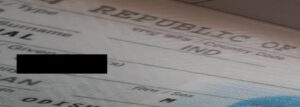
Fig 4: Dicuts
d) BARCODE: This feature is present on the back cover of the passport and even on page 35. It contains all the information about the traveler and on scanning the bar-code, all the information will be furnished.
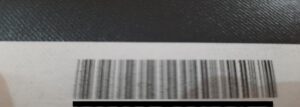
Fig 5: Barcode
e) WATERMARK: Indian passports have a watermark of the national emblem of India that is visible on the cover and the pages of the passport. This watermark is difficult to replicate and can be easily identified by examining the passport under different lighting conditions.
The watermark is 2 and a half Ashoka Chakra connected from head to head and toe to toe. We can observe this when you view the Visa page in transmitted light.

Fig 6: Watermark
2. ULTRA-VIOLET LIGHT EXAMINATION: In this examination, we observed the passport under UV light. Certain features show fluorescence under UV light. These features are:
a) 2 ASHOKA CHAKRA: we see If the front cover is under UV light, then 2 Ashoka Chakra is seen near the Emblem. Same with the back cover of the passport.

Fig 7: Ashoka Chakra Under UV Light
b) SADDLE STITCHING: On the middle page of the passport (page no-19), you can observe stitching which is done using fluorescent thread during its manufacture. On observing it under UV light, it produces fluorescence (red, yellow, green). We call this Saddle Stitching. On every visa page, you can also observe small fluorescent threads. We know this feature as “OPTIC FIBERS”.

Fig 8: Saddle Stitching & Optic Fibers
c) GUILLOCHES/ FINE LINE PATTERN: This is a floral representation of the passport present on all visa pages. We can see it only under UV light.
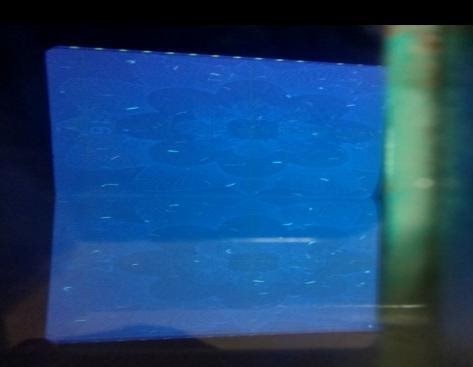
Fig 9: Guilloches
d) BIO-PAGE: Under UV light, you can observe certain writings such as “Government of India” (red color) and “Bharat Sarkar” (Green color). We can see this feature only under UV light and is a very essential feature to look upon.

Fig 10: Bio page under UV light
3. Holograms:
Indian passports have several holograms that are embedded in the cover and the pages of the passport. These holograms are difficult to replicate and can be easily identified by examining the passport under different lighting conditions.
4. Microtext:
Indian passports have micro text, which is the text that is printed in a very small font and can only be seen with a magnifying glass. Microtext is used to print the passport number, the name of the passport holder, and other information in a way that is difficult to replicate or alter.
5. Security thread:
Indian passports have a security thread that is embedded in the cover of the passport. This security thread is visible when the passport is held up to a light and can be used to verify the authenticity of the passport.
6. Laser-engraved photograph:
Indian passports have a laser-engraved photograph of the passport holder that is embedded in the cover of the passport. This photograph is difficult to replicate and can be easily identified by examining the passport under different lighting conditions.
7. OTHER EXAMINATION:
- WORD PROCESSOR: In this process, the area of concern (AOC) is selected and undergoes acquisition, thinning Grey and white scale conversion, and comparison to the genuine document [2].
- OCB-R: In every passport, there are 2 regions (visual inspection zone & machine-readable zone). MRZ (Machine Readable Zone) is the area that can be analyzed only using the OCB-R reader machine. This is only accessible to the authorities of Aviation [3].
CONCLUSION:
With the advancement of technology, experts need to advance security features because criminals also overcome the advances in technology and are involved in criminal activity. There is an urgent need in developing an e-passport that is being executed soon by the ministry in order to avoid tampering and to avoid the fake passport in the flow. To maintain the integrity of the passport it is very necessary to know the difference between a “Genuine passport” & “Fake passport”.
References
- Gupta, S., Gupta, K., Singla, A. (2016) “Advancement in Indian Passport- A Forensic Perspective” ‘International Research Journal of Engineering & Technology. Retrieved from; https://www.irjet.net/archives/V3/i11/IRJET-V3I11103.pdf
- Dar, Younis. (2017). Detection of counterfeit Indian passport using Image processing. 13140/RG.2.2.12582.22086.
- Gupta, Reeta. (2017). Passport Forgery and Forensic Examination of Indian Passport. Journal of Forensic Sciences & Criminal Investigation. 10.19080/JFSCI.2017.05.555658.
About the Author:
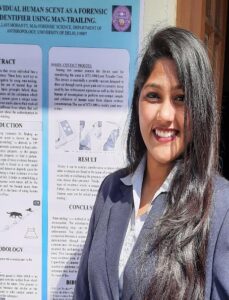 Pallavi Mohanty is an honest, proactive, hard-working, and multifaceted graduate who possesses academic knowledge of Forensic Science with the ability to face challenges in the future. She has completed her Bachelor’s in Forensic Science from Galgotias University as a “Top-rank holder” and currently pursuing her Master’s degree in Forensic Science from the University of Delhi. She has a keen interest in writing articles and review papers. Apart from academics, she is a freelance article writer and also contributes to various NGOs as a social worker. Currently, she is also involved in an internship under the guidance of the Department of Forensic Science, LEGAL DESIRE, and also volunteering for Sherlock Institute Forensic Science (SIFS).
Pallavi Mohanty is an honest, proactive, hard-working, and multifaceted graduate who possesses academic knowledge of Forensic Science with the ability to face challenges in the future. She has completed her Bachelor’s in Forensic Science from Galgotias University as a “Top-rank holder” and currently pursuing her Master’s degree in Forensic Science from the University of Delhi. She has a keen interest in writing articles and review papers. Apart from academics, she is a freelance article writer and also contributes to various NGOs as a social worker. Currently, she is also involved in an internship under the guidance of the Department of Forensic Science, LEGAL DESIRE, and also volunteering for Sherlock Institute Forensic Science (SIFS).






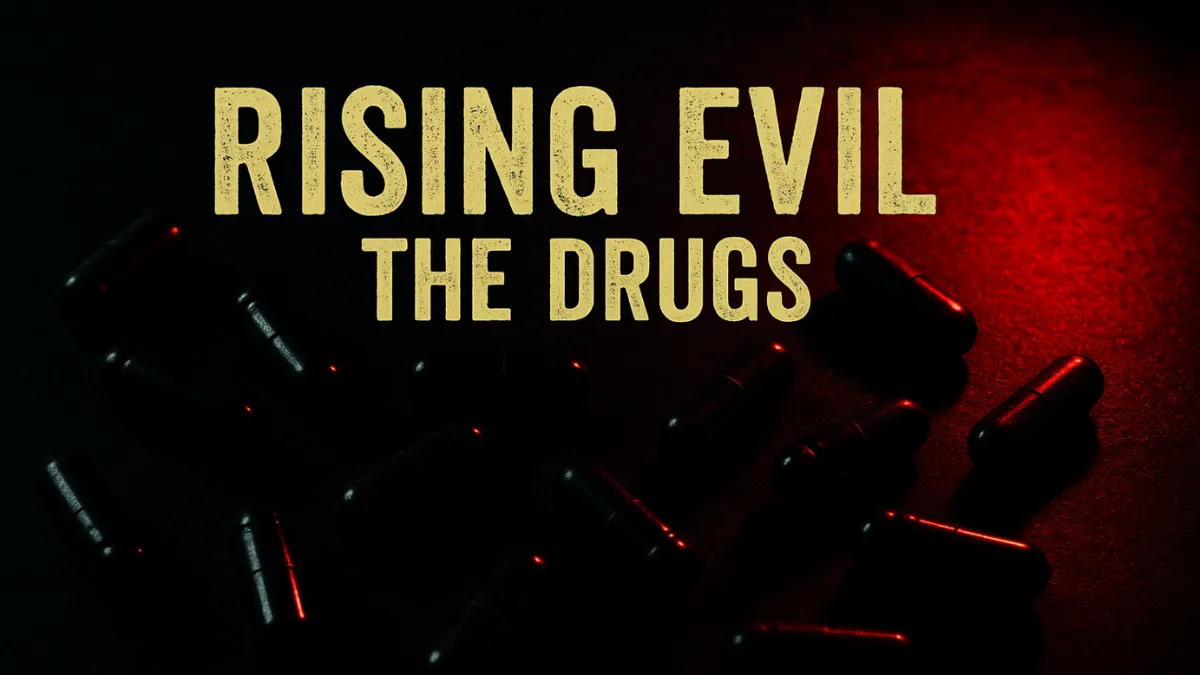


Leave a Reply